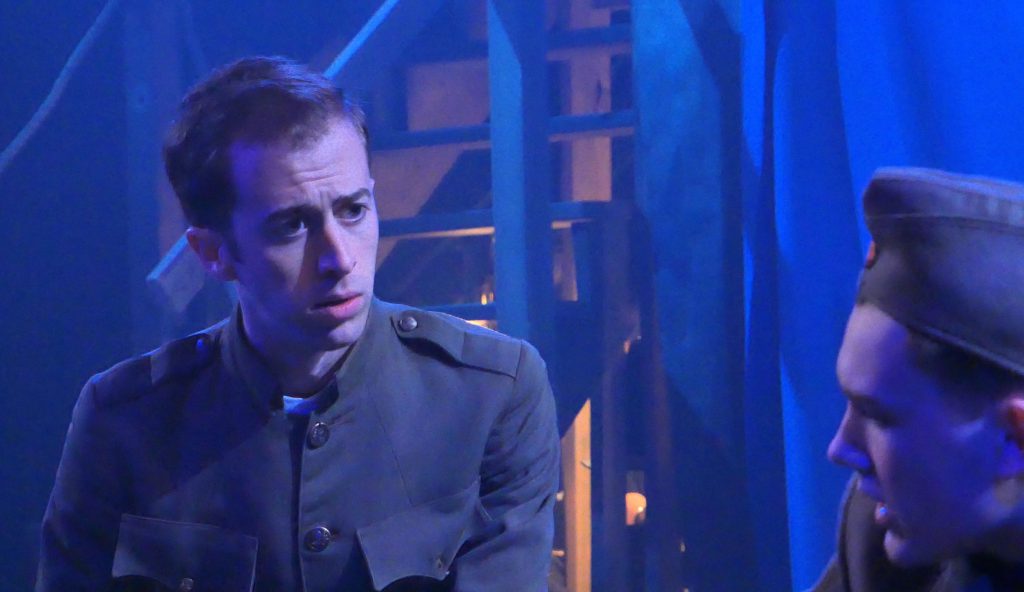Chicago Folks Operetta mounts the Chicago premiere of a landmark work by Kurt Weill
Johnny Johnson follows a pacifist into the trenches of WWI and beyond.
Chicago Folks Operetta has carved a niche over the past decade by specializing in long-forgotten hits from the “Silver Age” of European operetta in Vienna and Berlin in the 1910s and ’20s—schmaltzy, tuneful romantic comedies that evoke nostalgia for a simpler age before the First World War shattered the established order of European imperial politics and culture. But now—marking the 100th anniversary of America’s entry into World War I—CFO has taken a bold gamble on the long-overdue Chicago premiere of Kurt Weill and Paul Green’s 1936 operetta Johnny Johnson. Though not a success in its time, Johnny Johnson is a work of landmark historical significance. And despite some flaws, this production packs a real emotional impact with its quirky yet lyrical music, expressionistic visual design, and timeless theme of a common man caught up in the madness of war.
Set between 1917 and 1936, Johnny Johnson is the saga of a small-town American everyman. (The hero’s name was chosen because “Johnny Johnson” was the most common name on the rolls of American casualties in World War I.) Johnny is a simple, eager-to-please young fellow who makes his living as a sculptor of tombstones—the first of many ironic touches in Green’s script, which owes a clear debt to the didactic “epic theater” of Weill’s sometime collaborator Bertolt Brecht. A passionate pacifist, Johnny joins the army at the urging of his jingoistic fiancee, Minny Belle, to fight in what President Woodrow Wilson has dubbed the “war to end all war.” Once on the Western Front, Johnny—his naivete shattered by the reality of war—becomes convinced that war could be ended if only the peace negotiations were left to the soldiers themselves, rather than to political, military, religious, and corporate leaders. His efforts to prove his point are illustrated in a series of vignettes that are alternately satiric and sad, sentimental and sardonic.
Johnny Johnson was the first show Weill, a Jewish refugee from Hitler’s Germany, wrote for the American stage after he came to the U.S. in 1935. He and his wife and muse, singer-actor Lotte Lenya, were quickly drawn into the sphere of New York’s progressive Group Theater, which had been founded in 1931 by producer Cheryl Crawford, director Harold Clurman, and actor Lee Strasberg. During its ten-year existence, the Group premiered plays by Clifford Odets (Awake and Sing!, Waiting for Lefty, Golden Boy) and launched the careers of actors Lee J. Cobb, John Garfield, Sanford Meisner, and Stella Adler, dancer Anna Sokolow, and director Elia Kazan.
The Group recruited Weill and Pulitzer Prize-winning playwright-poet Paul Green to write an antiwar comedy in the style of a song-and-sketch revue, a popular form on the Depression-era New York stage. Directed by Strasberg, with musical direction by Lehman Engel, Johnny Johnson was a 1936 Broadway flop, due in large part to the clashing artistic visions of Weill, Green, and Strasberg. Weill went on to have more success with the musicals Knickerbocker Holiday, Lady in the Dark, One Touch of Venus, Street Scene, and Lost in the Stars; after his death in 1950, an off-Broadway revival of his 1928 The Threepenny Opera became his biggest and most enduring hit.
Meanwhile, Green revised Johnny Johnson for a 1937 Los Angeles production by the Federal Theatre Project, restoring material that Strasberg had cut. This version is “most faithful to Green and Weill’s original intentions,” according to a program note by Weill expert Timothy Carter, whose 2012 edition of the work for the Kurt Weill Foundation for Music is the one used here.
Weill’s remarkable music is the work of a classically trained composer dedicated to bridging then-established barriers between elite “art” and populist “entertainment.” The songs are melodic and appealing, yet punctuated with unexpected chromatic twists—at once lyrical and abrasive, sentimental and seductive, charming and ironic. There are waltzes, fox-trots, and tangos, operetta chorales and patriotic marches, even a cowboy ballad. The show’s loveliest number, a gently jaunty anthem titled simply “Johnny’s Song,” sounds like a combination of a Weimar-era cabaret selection and a Woody Guthrie folk song.
Gabriel di Gennaro brings honesty and off-kilter grace to the role of Johnny; soprano Kaitlin Galetti delivers Minny’s operetta aria “Oh Heart of Love” beautifully; and Maxwell Seifert’s clarion tenor is well suited to the roles of two of Johnny’s tormentors, the narcissistic Captain Valentine and an insane psychiatrist who treats Johnny for “peace monomania.” Director George Cederquist’s uneven staging is sometimes stodgy, especially during the long instrumental interludes that accompany scene changes; but conductor Anthony Barrese’s musical leadership of the 12-piece chamber orchestra certainly makes the music worth the time given it. And the expressionistic visual design by Eric Luchen (set) and Erik Barry (light), clearly inspired by the work of Weimar-era German cartoonist Georg Grosz, evokes an aptly dreamlike atmosphere.

